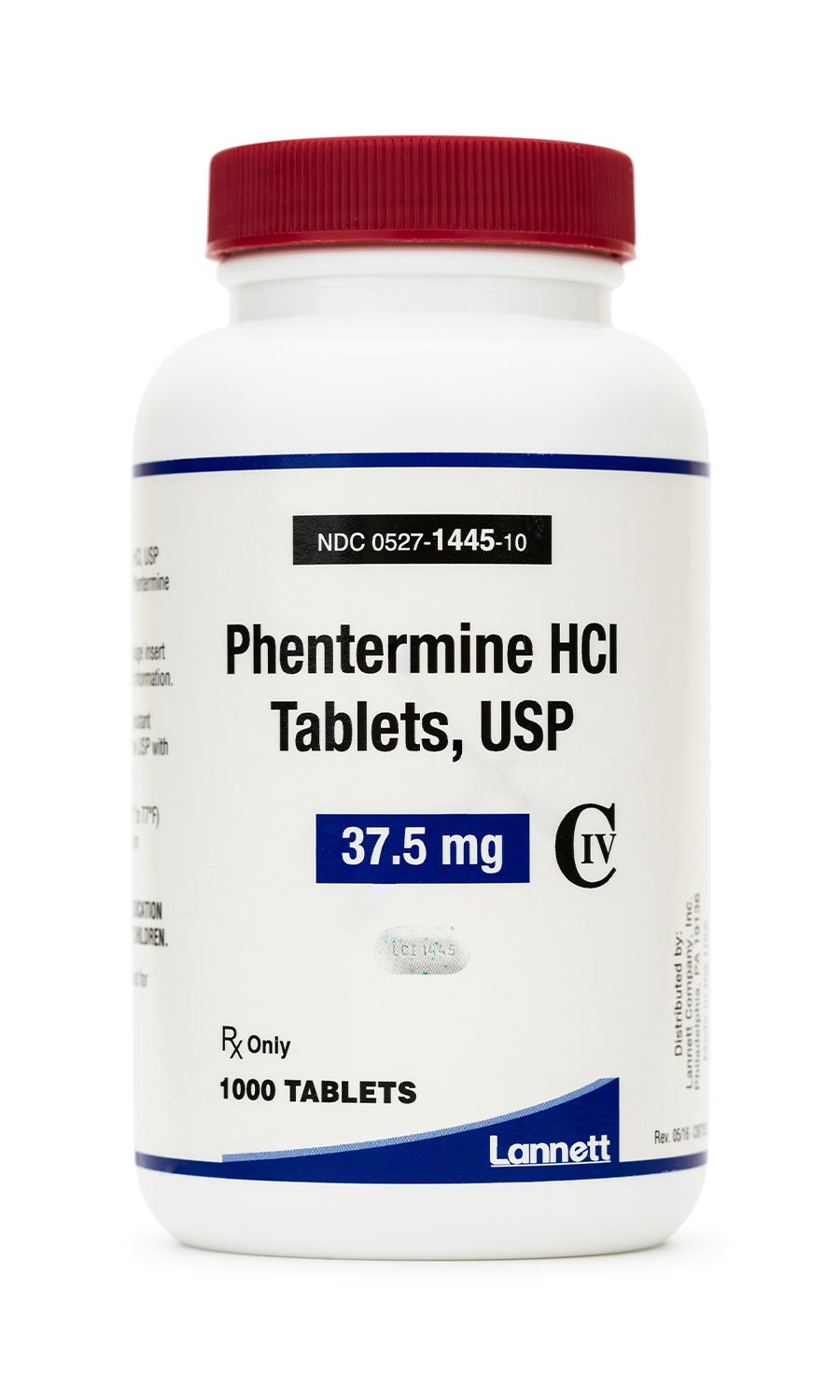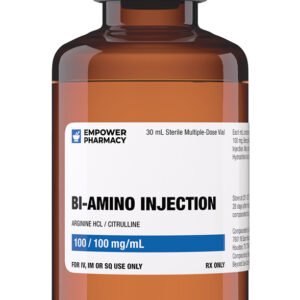The safety of phentermine when used with other anorexiant agents such as amphetamine, benzphetamine, dexfenfluramine, dextroamphetamine, diethylpropion, ephedrine, fenfluramine, and sibutramine is controversial and concurrent use should be avoided. The role of phentermine in the production of cardiac valvulopathy when combined with dexfenfluramine, fenfluramine, or other medications for weight loss is uncertain. The combined use of these agents may have the potential for additive side effects, such as hypertensive crisis or cardiac arrhythmias. Similarly, because phentermine is a sympathomimetic and anorexic agent (i.e., psychostimulant) it should not be used in combination with other sympathomimetics or psychostimulants for weight loss, including OTC preparations, and herbal products that may contain ephedra alkaloids or Ma huang.
Phentermine, which increases catecholamine release, can increase blood pressure; this effect may be additive with the prolonged vasoconstriction caused by ergot alkaloids. Monitoring for cardiac effects during concurrent use of ergot alkaloids with phentermine may be advisable.
Concurrent use of bromocriptine and some sympathomimetics such as phentermine should be approached with caution. One case report documented worsening headache, hypertension, premature ventricular complexes, and ventricular tachycardia in a post-partum patient receiving bromocriptine for lactation suppression who was subsequently prescribed acetaminophen; dichloralphenazone; isometheptene for a headache. A second case involved a post-partum patient receiving bromocriptine who was later prescribed phenylpropanolamine; guaifenesin and subsequently developed hypertension, tachycardia, seizures, and cerebral vasospasm.
In theory, an interaction is possible between cabergoline, an ergot derivative, and some sympathomimetic agents such as phentermine. Use of the ergot derivative bromocriptine for lactation suppression in conjunction with a sympathomimetic (i.e., isometheptene or phenylpropanolamine) for other therapeutic uses has resulted in adverse effects such as worsening headache, hypertension, ventricular tachycardia, seizures, sudden loss of vision, and cerebral vasospasm.
Concurrent use of dronabinol, THC or nabilone with sympathomimetics may result in additive hypertension, tachycardia, and possibly cardiotoxicity.
Monoamine oxidase inhibitors (MAOIs), or drugs that possess MAO-inhibiting activity such as furazolidone, linezolid, or procarbazine, can prolong and intensify the cardiac stimulation and vasopressor effects of phentermine. Phenelzine and tranylcypromine appear to produce the greatest risk since these two MAOIs also have intrinsic amphetamine-like activity. In the presence of MAOIs, phentermine and other drugs that cause release of norepinephrine induce severe cardiovascular and cerebrovascular responses. It is unclear if selegiline, an inhibitor of MAO type B, can also predispose to this reaction. Phentermine should not be administered during or within 14 days following the use of most MAOIs or drugs with MAO-inhibiting activity. Rasagiline is a selective MAO-B inhibitor at manufacturer recommended doses; therefore, serious reactions with sympathomimetics are not ordinarily expected. However, because a case of elevated blood pressure occurred during use of rasagiline and a sympathomimetic ophthalmic preparation, caution is advised when rasagiline is administered with sympathomimetics.
The pressor response to some sympathomimetics is exaggerated in patients currently receiving tricyclic antidepressants. Concomitant use of tricyclic antidepressants with sympathomimetics, including phentermine, should be avoided whenever possible.
Phentermine has vasopressor effects and may limit the benefit of antihypertensive agents particularly sympatholytic agents such as guanadrel, guanethidine, methyldopa or reserpine. Phentermine may displace guanethidine from the neuron and antagonize the neuronal blockade caused by guanethidine. Concomitant use of phentermine with methyldopa or reserpine may antagonize the antihypertensive effects of these agents. Although leading drug interaction texts differ in the potential for an interaction between phentermine and this group of antihypertensive agents, these effects are likely to be clinically significant and have been described in hypertensive patients on these medications.
Use caution in combining phentermine with antidiabetic agents. Phentermine exhibits sympathomimetic activity. Sympathomimetics may increase blood sugar via stimulation of beta2-receptors which leads to increased glycogenolysis. A pharmacodynamic interaction with antidiabetic agents may occur. Diabetic patients may have decreased requirements of insulins, sulfonylureas, or other antidiabetic agents in association with the use of phentermine and the concomitant dietary regimen and weight loss. As long as blood glucose is carefully monitored to avoid hypoglycemia or hyperglycemia, it appears that phentermine can be used concurrently.
Halogenated anesthetics may sensitize the myocardium to the effects of the sympathomimetics. Because of this, and its effects on blood pressure, phentermine should be discontinued several days prior to surgery.
Concurrent use of phentermine and phenothiazines may antagonize the anorectic effects of phentermine. In addition, psychostimulants can aggravate psychotic states.
Although not studied, the concomitant use of ethanol and phentermine may result in an adverse reaction and should be avoided.
Phentermine, like other sympathomimetics, is contraindicated in selected patients with thyroid disease; caution should be used if coadministering thyroid hormones with phentermine.
Atomoxetine has been reported to increase blood pressure and heart rate, probably via inhibition of norepinephrine reuptake. Due to an additive pharmacodynamic effect, phentermine and atomoxetine should be used together cautiously, particular in patients with a history of cardiac disease. Consider monitoring heart rate and blood pressure at baseline and regularly throughout treatment if these agents must be used together.
Bupropion is associated with a dose-related risk of seizures. Excessive use of psychostimulants, such as phentermine or the combination of phentermine; topiramate, may be associated with an increased seizure risk; therefore, seizures may be more likely to occur in patients receiving these weight loss aides with bupropion or bupropion-containing combinations. Other side effects might also occur, such as dizziness, blood pressure changes, or other side effects. Patients should be closely monitored if this combination is necessary. Do not combine therapy with phentermine or phentermine-combinations and bupropion; naltrexone due to this risk and the duplication of therapy for weight loss.
Due to the pharmacology of salmeterol, caution and close observation should also be used when fluticasone; salmeterol is used concurrently with other adrenergic sympathomimetics, administered by any route, to avoid potential for increased cardiovascular effects based on the pharmacology of salmeterol.
Use phentermine and selective serotonin reuptake inhibitors (SSRIs) or serotonin norepinephrine reuptake inhibitors (SNRIs) together with caution; use together may be safe and efficacious for some patients based on available data, provided the patient is on a stable antidepressant regimen and receives close clinical monitoring. Regular appointments to assess the efficacy of the weight loss treatment, the emergence of adverse events, and blood pressure monitoring are recommended Watch for excessive serotonergic effects. Phentermine is related to the amphetamines, and there has been historical concern that phentermine might exhibit potential to cause serotonin syndrome or cardiovascular or pulmonary effects when combined with serotonergic agents. One case report has been received of adverse reactions with phentermine and fluoxetine. However, recent data suggest that phentermine’s effect on MAO inhibition and serotonin augmentation is minimal at therapeutic doses, and that phentermine does not additionally increase plasma serotonin levels when combined with other serotonergic agents. In large controlled clinical studies, patients were allowed to start therapy with phentermine or phentermine; topiramate extended-release for obesity along with their antidepressants (e.g., SSRIs or SNRIs, but not MAOIs or TCAs) as long as the antidepressant dose had been stable for at least 3 months prior to the initiation of phentermine, and the patient did not have suicidal ideation or more than 1 episode of major depression documented. In analyses of the results, therapy was generally well tolerated, especially at lower phentermine doses, based on discontinuation rates and reported adverse events. Because depression and obesity often coexist, the study data may be important to providing optimal co-therapies.
Use phentermine and vortioxetine together with caution; use together may be safe and efficacious for some patients based on available data, provided the patient is on a stable antidepressant regimen and receives close clinical monitoring. Regular appointments to assess the efficacy of the weight loss treatment, the emergence of adverse events, and blood pressure monitoring are recommended. Watch for excessive serotonergic effects. Phentermine is related to the amphetamines, and there has been historical concern that phentermine might exhibit potential to cause serotonin syndrome or cardiovascular or pulmonary effects when combined with serotonergic agents. One case report has been received of adverse reactions with phentermine and the antidepressant fluoxetine. However, recent data suggest that phentermine’s effect on MAO inhibition and serotonin augmentation is minimal at therapeutic doses, and that phentermine does not additionally increase plasma serotonin levels when combined with other serotonergic agents. In large controlled clinical studies, patients were allowed to start therapy with phentermine or phentermine; topiramate extended-release for obesity along with their antidepressants (e.g., SSRIs or SNRIs, but not MAOIs or TCAs) as long as the antidepressant dose had been stable for at least 3 months prior to the initiation of phentermine, and the patient did not have suicidal ideation or more than 1 episode of major depression documented. In analyses of the results, therapy was generally well tolerated, especially at lower phentermine doses, based on discontinuation rates and reported adverse events. Because depression and obesity often coexist, the study data may be important to providing optimal co-therapies.







Reviews
There are no reviews yet.